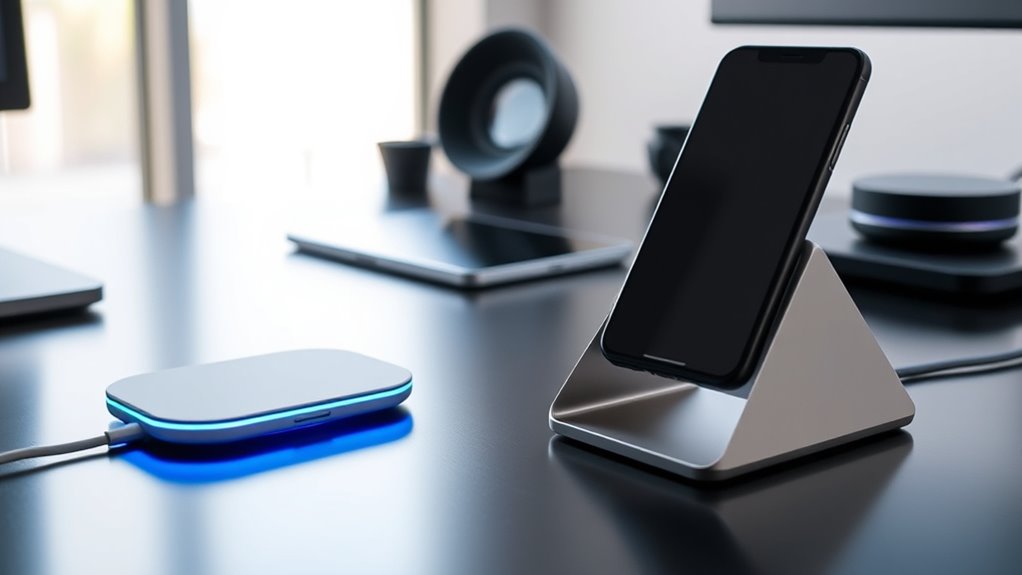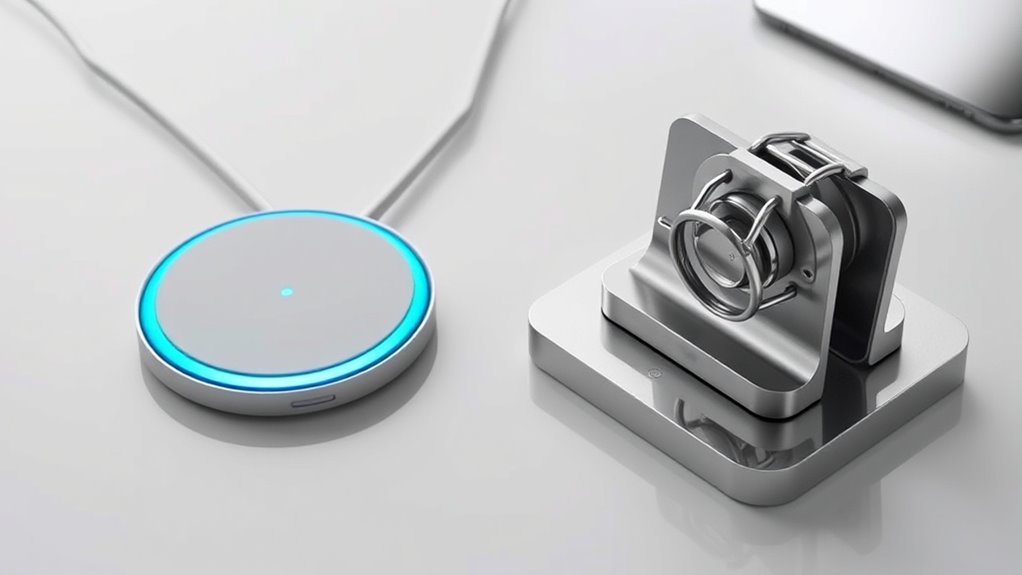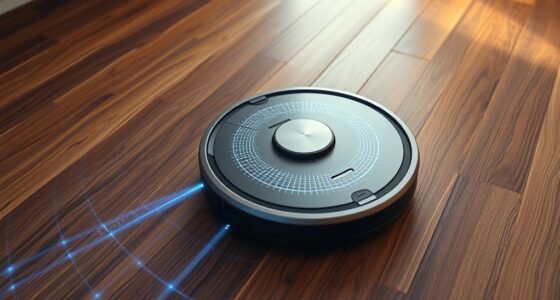Wireless charging pads offer a clutter-free, convenient way to power devices without plugging in, but they may charge slower and produce more heat, potentially impacting battery health over time. Magnetic docks provide faster, more stable charging through a physical connection, which can extend port longevity. Your choice depends on whether you prioritize ease and compatibility or speed and long-term device health. To explore the key differences and suitability, keep going to discover more.
Key Takeaways
- Wireless charging pads offer convenience and device compatibility, eliminating the need for physical ports and reducing port wear.
- Magnetic docks provide faster charging with stable physical connections, enhancing efficiency and reducing energy loss.
- Wireless pads may cause slight battery heat and slower charging, potentially impacting long-term battery health.
- Magnetic docks depend on specific ports (USB-C, Lightning) and magnetic attachments, requiring proper alignment.
- User preference depends on prioritizing ease of use and setup versus faster, more stable charging and port longevity.

When it comes to charging your devices, choosing the right solution can make a big difference in convenience and efficiency. Wireless charging pads and magnetic docks each have their strengths, but understanding how they impact battery efficiency and port compatibility can help you make an informed decision. Wireless pads are designed to offer a clutter-free experience. You simply place your device on the pad, and power transfers wirelessly through electromagnetic fields. This convenience can save time and reduce wear on your device’s charging port, which is especially beneficial if you frequently connect and disconnect cables. However, wireless charging often results in slightly lower battery efficiency because of energy loss during transmission. It may take longer to charge compared to wired options, and some devices may heat up more during the process, potentially impacting battery health over time. Additionally, necessary cookies enable basic site functionalities, ensuring a smooth user experience during your device setup and charging process.
On the other hand, magnetic docks typically connect via a specific port, such as USB-C or Lightning, which ensures a stable and efficient power transfer. This port compatibility means you usually get faster charging speeds and better battery efficiency because less energy is lost during the process. The magnetic feature in these docks helps align your device precisely, reducing wear on the port and minimizing the risk of damage from repeated plugging and unplugging. Plus, many magnetic docks are designed to be compatible with a range of devices, making them versatile if you own multiple gadgets. Still, they rely on a physical connection, which can be less convenient if you’re constantly on the move or prefer a clutter-free setup. You’ll need to carry around the dock and ensure your device remains aligned correctly to avoid interruptions.
Both options have their trade-offs in terms of port compatibility. Wireless pads eliminate the need for physical ports, making them compatible with more devices regardless of the port type, but they require your device to support wireless charging technology. Magnetic docks, however, need the specific port and magnetic connection, which means they’re not universally compatible with all devices unless they have the right port and magnetic attachment. If you prioritize quick, efficient charging and port longevity, a magnetic dock might be your best choice. If you prefer ease of use and a cleaner setup, a wireless pad could be more suitable. Ultimately, your decision depends on your device compatibility, charging habits, and whether you value speed over convenience.
Frequently Asked Questions
Can Magnetic Docks Charge Multiple Devices Simultaneously?
Yes, magnetic docks can charge multiple devices simultaneously, especially if they feature multi-device charging capabilities. They provide magnetic stability, ensuring your devices stay securely in place while charging. Many magnetic docks have multiple magnetic connectors or pads, allowing you to connect and charge your phone, smartwatch, and earbuds at the same time. This setup offers convenience and efficiency, making it a great choice for streamlined multi-device charging.
Are Wireless Charging Pads Compatible With All Smartphone Brands?
You might wonder if wireless charging pads work with all your smartphones. Compatibility issues can arise due to different wireless standards like Qi, which most modern devices support, but some older or less common brands may not. Always check your phone’s specifications and the pad’s compatibility list to guarantee smooth charging. While most popular brands now support standard wireless charging, a few niche models might still face compatibility issues.
Do Magnetic Docks Affect the Device’s Battery Longevity?
Magnetic docks generally don’t negatively impact your device’s battery longevity if used properly. They don’t cause significant battery degradation or alter your charging cycle. However, frequent or improper use might lead to minor wear over time. It’s best to follow manufacturer guidelines, avoid overcharging, and use quality docks to guarantee your device maintains peak battery health. Proper care helps prevent unnecessary strain on your battery’s lifespan.
How Do Charging Speeds Compare Between Pads and Docks?
Imagine your device gliding onto a charging surface, ready to power up. Charging speeds depend on charging efficiency and power output, and magnetic docks often deliver faster, more consistent power due to direct contact and higher wattage. Wireless pads can be slower, with variable efficiency from surface alignment. So, if quick charging matters, a magnetic dock’s higher power output usually outpaces wireless pads, making your device juice up faster.
Are Magnetic Docks More Secure Than Wireless Charging Pads?
You might find magnetic docks more secure because of their magnetic strength, which keeps your device firmly in place, reducing the risk of accidental disconnection. In contrast, wireless charging pads may pose security risks if they’re easily moved or bumped, especially on unstable surfaces. So, if you want better security for your device, magnetic docks generally offer a more reliable hold, minimizing the chances of slips or falls.
Conclusion
So, which charging method will you choose? Wireless pads offer convenience, but magnetic docks promise a secure connection. Each has its strengths—and your decision could change how you power up every day. Are you ready to embrace the future of charging, or will you stick with what’s familiar? The choice is yours, and the possibilities are endless. One thing’s certain: the next move could transform your tech experience forever. Are you prepared for what’s coming?









